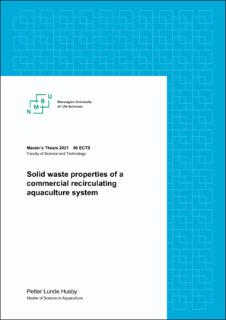| dc.description.abstract | Impact of solid waste on the rearing of Atlantic salmon smolt (Salmo salar) in Recirculating Aquaculture Systems (RAS) is important knowledge for future optimization of land-based aquaculture. The water quality in a commercial RAS department was tested, and different properties in regard to solid waste impact in the system was investigated. The RAS department treated the process water through particle separation (drum filters), biofiltration (MBBR) and CO2 removal through vacuum degassers as the main units for handling waste from the rearing of the fish. Methods for analysis of the water were Particle size distribution (PSD), TSS (Total suspended solids), COD (Chemical oxygen demand), BOD5 (Biochemical oxygen demand), TS (Total solids, fixed & volatile), Total Nitrogen, Total Phosphorus and measurements on turbidity. The main findings were the limited capacity of removal of microparticles below 20 μm, which was assumed the main reason for the coloring and murkiness of the process water. The high number of these particles was the major contributor to turbidity measurements. Removal efficiency of particle separation setup was evaluated. Effectiveness of drum filters based on TSS removal was 16 % by 60 μm mesh apertures and 18 % by 20 μm apertures. The work discussed possible solutions for treatment to achieve better water clarity and less solid load than achievable in the investigated system. The cost and benefits of treatment aiming for better water clarity is important to evaluate as solids may directly impact optimal production, and the optical view in the water column may affect stress factors for the salmon smolt. There is a need for further understanding of the optimal conditions for the health and growth of salmon smolt, in regard to the impact of elevated solid concentrations and different sizes of suspended particles. | en_US |

